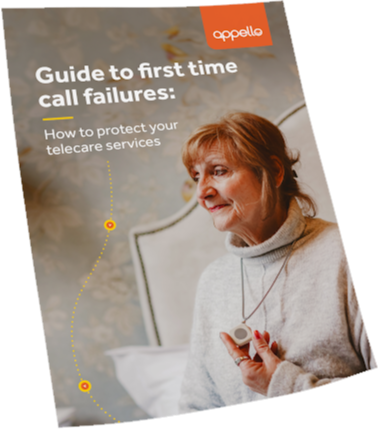The need to move away from analogue and embrace digital telecare is widely accepted. The upgrade of the UK’s telecoms networks is well underway, with over c120 exchanges planned for digital upgrade work in 2021.
The impact of analogue has been seen for some time, with a reported average 10% of first-time calls across the UK resulting in call failure and subsequent redials – creating delays in emergency response.
Until late 2020, housing, care and service providers were presented with two options;
• Full digital upgrade.
• Hybrid solution, whereby only part of the site equipment is upgraded to digital.
In November, Appello launched, Appello DigitalBridge, a cloud protocol conversion solution. It enables housing providers to utilise their existing analogue equipment, converting the call protocol to digital in the cloud so that it can traverse the digital telecoms network safely. Mitigating the risks of first-time call failures.
So, there are now three options available, but which solution is right for your organisation?
I will start by stating that although this blog will highlight the benefits of our own Smart Living Solutions, it is not a sales pitch. Instead it is designed to help you navigate the technology enabled care (TEC) market, providing clarity to the benefits and limitations of the options available.
Firstly, it is important to understand your desired outcomes when reviewing the market. Are you just attempting to overcome call failures and mitigate risk, or does your organisation have a vision and strategy to introduce the wider benefits that digital technology can offer?
Potentially, you have a short and long-term strategy?
Safety
If your immediate objective is to mitigate the first-time call failure risks, then all three options – bridge, hybrid or full digital – are appropriate. However, the potential safety improvements don’t stop there. Digital systems can make other significant improvements to safety that should be considered:
• Analogue systems can take upwards of 1m30s to connect to a monitoring centre, a significant time in a critical incident. This can be dramatically reduced. Smart Living Solutions can reduce this to just 3s, and Hybrid solutions to approximately 10-30s*.
• Analogue systems are limited to just a single line out of a development. This means only one person/device (including the door entry system) can connect to a monitoring centre at once.
During this time, all other emergencies queue and are responded to after the previous call has complete.
This can result in very significant delays, and during larger emergencies there will often be multiple calls simultaneously. A full digital telecare system, such as Smart Living Solutions, eradicates this issue as all connections can reach an operator at the same time. Hybrid systems are limited to just two calls at the same time.
• Analogue systems often only provide ‘mono’ speech, which works like a walkie talkie, whereby only one person speaks at a time. With the emotions and confusion of an emergency this can cause issues. Smart Living Solutions, Appello DigitalBridge, and we believe all Hybrid solutions eradicate this issue.
Wellbeing
A move to digital for the Technology Enabled Care sector has provided significant advantages, widening the scope of what is possible through technology. Video door entry, video communication, notifications, messaging, Wifi and Bluetooth connectivity, have all become benefits for those with digital TEC.
For management and onsite teams, digital is offering far greater control and insight into service usage.
Furthermore, a full digital telecare solution can set the foundations for an organisation’s digital transformation now and in the future. Innovation is ripe across technology in our sector globally, from wellbeing devices, to smart home capabilities. These are the technologies that the customer of tomorrow is going to require and expect.
Therefore, it is imperative to consider, is your focus just safety, or does your organisation want to be delivering solutions that can really transform lives and service delivery.
If the later, then our Appello DigitalBridge solution is not the answer. It is designed to help an organisation in the short term – ‘bridge the gap’ – and mitigate safety risks. Therefore, it may well be a very good solution whilst you implement more dynamic plans, but it is not a long-term solution.
Hybrid or Fully Digital?
It can be difficult to determine the difference; which is why it’s important you involve your digital telecare and IT experts early in your projects. In short, a full digital system will be digital from end to end. Meaning that every part of the installation will be digital kit, designed to speak to a monitoring centre that utilises digital protocols. A Hybrid, as the name suggests, will only be digital in places. Although this may save you a few pounds (in the short term), it comes with its limitations.
Depending on the Hybrid solution you consider you may find that it includes some of the features such as video calling, WIFI connectivity and a management application. However, we don’t believe you will find a model with all, so you may have to compromise on your specification.
A full digital system, however, like our own Smart Living Solutions, can provide all these features in one package – and there is scope to customise to meet your needs.
Even more important though is that a Hybrid solution will not provide you with the foundations to take advantage of this new era of digital Technology Enabled Care. The integration capabilities and open protocol approach don’t rival that of a full digital solution. This is because a full digital solution has been designed specifically for the digital world, to which we are all accustomed.
Key Takeaways
- Involving your technical experts from the beginning will help you to clearly understand the capabilities of the different solutions on the market and how they compare with your organisations specific requirements.
- Clearly identify your organisations desired outcomes, both short-term and long-term, and where possible consider the implications of any short-term actions on your long-term objectives.
- There are now three types of solution to mitigating the risks of call failures, bridge, Hybrid or full-digital. To give a snapshot of how they compare we have created the below chart which reflects the current market for Technology Enabled Care services.

You can find more details on the issue of first time call failures in our latest guide, which is available to download now

Talk to us to discuss your requirements and find out about our cost-effective and future proof digital solutions.



